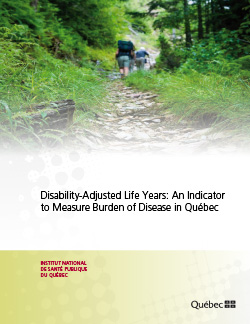Disability-Adjusted Life Years: An Indicator to Measure Burden of Disease in Québec
In the early 1990s the indicator disability-adjusted life years (DALY) was developed in response to a need for data used in health decision-making on an international scale. Since then, a number of countries have used this indicator to produce territorial estimates.
This indicator is of interest insofar as it considers both mortality and loss of functional health. It also allows for comparison of estimates produced for various health conditions and to rank their impacts on the health of a population under study. The impacts of disease on mortality are measured using years of life lost (YLL) and loss of functional health is estimated using years lost due to disability (YLD). DALYs are calculated as the sum of YLL and YLD.
The objectives of this report are to:
- introduce the indicator disability-adjusted life years and its components;
- describe the estimation methods used and the main methodological limitations; and
- present the first Québec estimates of DALYs for certain health conditions having a high prevalence or mortality rate in Québec.
DALYs and their components were computed for suicide and nine chronic diseases as well as for all causes in Québec for the period 2002-2006. Results show that the health conditions selected represent 59% of DALYs in Québec. Tumours, mental and behavioural disorders and ischemic heart disease cause the highest burden. Suicide, ischemic heart disease, tumours, hypertensive disease and cerebrovascular disease have a greater impact on mortality whereas osteoarthritis, asthma and mental and behavioural disorders have a greater effect on functional health. For both sexes, suicide is an important cause of premature death, as are tumours in women. Suicide and mental and behavioural disorders are important causes of burden among young people aged 15 to 29.
DALYs provide an alternative way to present a comprehensive profile of the population's health status with information derived from a variety of sources. One advantage of this indicator is that it breaks down information not only by disease, sex and age in an interesting manner, but also by distinct mortality and functional health elements. Moreover, its international use ensures that the methodology constantly improves. DALYs can also be used to assess the burden of a wide array of health problems, risk factors and some socioeconomic characteristics of the population.
The synthesis is also available: Disability-Adjusted Life Years: An Indicator to Measure Burden of Disease in Québec - Synthesis


